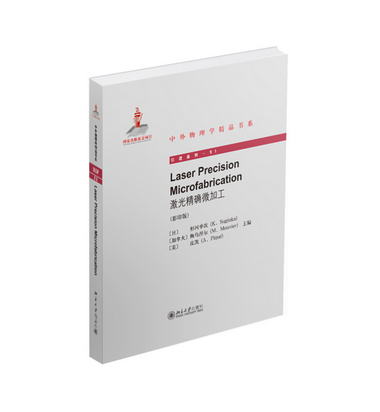| | | | 激光精確微加工(英文影印版) | | 該商品所屬分類:圖書 -> 北京大學出版社 | | 【市場價】 | 750-1088元 | | 【優惠價】 | 469-680元 | | 【作者】 | 杉岡幸次梅烏涅爾皮凱 | | 【出版社】 | 北京大學出版社 | | 【ISBN】 | 9787301248287 | | 【折扣說明】 | 一次購物滿999元台幣免運費+贈品
一次購物滿2000元台幣95折+免運費+贈品
一次購物滿3000元台幣92折+免運費+贈品
一次購物滿4000元台幣88折+免運費+贈品
| | 【本期贈品】 | ①優質無紡布環保袋,做工棒!②品牌簽字筆 ③品牌手帕紙巾
|
|
| 版本 | 正版全新電子版PDF檔 | | 您已选择: | 正版全新 | 溫馨提示:如果有多種選項,請先選擇再點擊加入購物車。*. 電子圖書價格是0.69折,例如了得網價格是100元,電子書pdf的價格則是69元。
*. 購買電子書不支持貨到付款,購買時選擇atm或者超商、PayPal付款。付款後1-24小時內通過郵件傳輸給您。
*. 如果收到的電子書不滿意,可以聯絡我們退款。謝謝。 | | | |
| | 內容介紹 | |

出版社:北京大學出版社 ISBN:9787301248287 版次:1 商品編碼:11580798 品牌:北京大學出版社 包裝:平裝 叢書名:中外物理學精品書繫 開本:16開 出版時間:2014-10-01 用紙:膠版紙 頁數:364 作者:杉岡幸次,梅烏涅爾,皮凱
" 編輯推薦 激光能量高度集中,而且便於操控,能夠進行精細加工。正因為這樣,激光加工技術的應用非常迅猛,已經形成了龐大的產業。同時,激光精確加工的技術本身也在蓬勃發展。作為詳細講述這一領域諸多方面的專著,《激光精確微加工(英文影印版)》對於國內相關領域的工程師和科學家,以及研究生來說都是不可多得的佳作。 內容簡介 小型化和高精度快速成為對很多工藝流程和產品的要求。因此,利用激光微加工技術來實現這一要求得到了廣泛關注。《激光精確微加工(英文影印版)》內容有16章,覆蓋了激光微處理技術的各個方面,從基本概念到在無機或生物材料上的工程應用。《激光精確微加工(英文影印版)》綜述了在激光處理領域的研究和技術發展水平。讀者對像為本領域的研究者和研究生。 作者簡介 杉岡幸次(K. Sugioka),日本理化學研究所(RIKEN)研究員。 目錄 Process Control in Laser Material Processing
for the Micro and Nanometer Scale Domains
Henry Helvajian
1.1 Introduction
1.2 Laser Processing
1.2.1 Laser Wavelength
1.2.2 Laser Power
1.2.3 Laser Dose
1.2.4 Laser Beam
1.2.5 Laser Pulse Temporal Profile
1.2.6 Pattern Generation
1.3 Possible Steps Forward
1.4 Conclusions
References
Theory and Simulation of Laser Ablation — from Basic
Mechanisms to Applications
Laurent J. Lewis and Danny Perez
2.1 Introduction
2.2 Basic Physics
2.2.1 Light—Matter Interaction
2.2.2 Material Removal from the Target:
The Basics of Ablation
2.3 Ablation in the Thermal Regime
2.3.1 Thermodynamics
2.3.2 Conventional Wisdom: Early Theories
2.3.3 A New Understanding
2.3.4 Computer Models
2.3.5 The Femtosecond Regime
2.3.6 Picosecond Pulses and Beyond
2.3.7 Molecular Solids
2.4 Materials Processing
2.4.1 Nanoparticle Production in Solvents
2.4.2 Damages and Heat Affected Zones
2.5 Conclusions and Perspectives
References
Laser Devices and Optical Systems for Laser Precision
Micro fabrication
4 Fundamentals of Laser—Material Interaction and Application to Multiscale Surface Modification
5 Temporal Pulse Tailoring in Ultrafast Laser Manufacturing Technologies
6 Laser Nanosurgery, Manipulation, and Transportationof Cells and Tissues
7 Laser Synthesis of Nanomaterials
8 UItrafast Laser Micro— and Nanostructuring
9 3D Fabrication of Embedded Microcomponents
10 Micromachining and Patterning
11 Laser Transfer Techniques for Digital Microfabrication
12 Hybrid Laser Processing of Transparent Materials
13 Drilling, Cutting, Welding, Marking and Microforming
Index 查看全部↓ 精彩書摘 《激光精確微加工(英文影印版)》:
A number of laser processing research studies have pointed to the use of morepulses and lower fluences. Consequently, this has generated interest on exploringthe effects of tailored photon fluxes on materials processing. How might a desiredphoton flux be expressed for an application? One approach could be in the form ofprescribed information scripts in which relevant processing parameters are definedand can be implemented by appropriate light valve devices on demand [64]. For thesystem to operate efficiently, the light valves must be integrated with in situ feedbackfrom the photophysical event. This is likely to come via spectroscopic signaturesthat are sensed and analyzed for deciding the next course of action. The practicalquestion is whether a photon flux control system, such as described, could be realized when operating at near real time processing speeds. The analysis is easier to dofor a direct-write patterning tool. Assume a processing laser with 50 MHz repetitionrate (pulses separated by 20 ns) that is brought to a 1 um (dia) focus on a target.Assume also that the patterning tool can move at a hefty speed of 1 m/sec (e.g.,Aerotech Corp. ABLS000 air bearing stage) which means that the patterning toolcan service 106 spot-sizes/sec. At the maximum velocity, the average time the patterning tool spends over a single spot-size is 1 us. There are now optical sensors withsubnanosecond response times and typical electrical signal transfer times in common cabling run about 3 ns/m. Microprocessor speeds have significantly evolved inthe past 15 years with the 2007 PC CPU tests showing the Intel CORE 2 ExtremeQX6800 processor capable of over 37 GFLOPS (Giga FLoating point OperationsPer Second). Finally, in the early 1990s, there was literature on acousto-optic modulators (e.g., Ti:LiNbO3) with bandwidths near 20 GHz [70] and current analog todigital convertors (ADCs) can operate up to 2 G samples per sec (e.g., Delphi Engineering ADC3244: 2GSPS, 10 bit accuracy and an integral field programmable gatearray). Given this information and the fact that for this example the average durationof time spent over a single spot-size is 1 us, it becomes possible to assemble a control system whereby information from a sensor is analyzed by the microprocessor(e.g., for GO/NO-GO or via a complex decision tree), and this information is sentto a light switch which either adds or subtracts extra laser pulses accordingly.
…… 查看全部↓
" | | |
| | | | |
|




